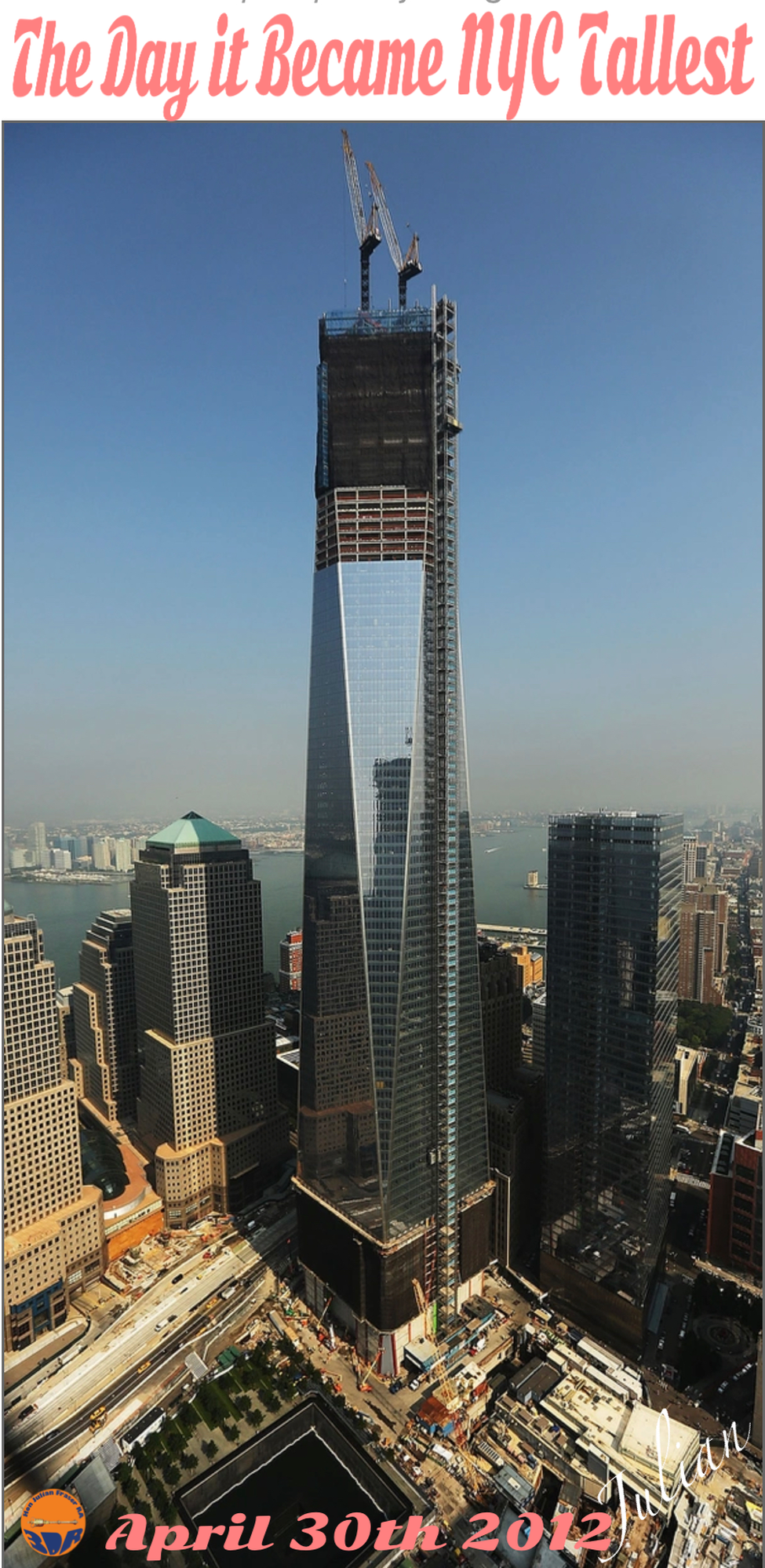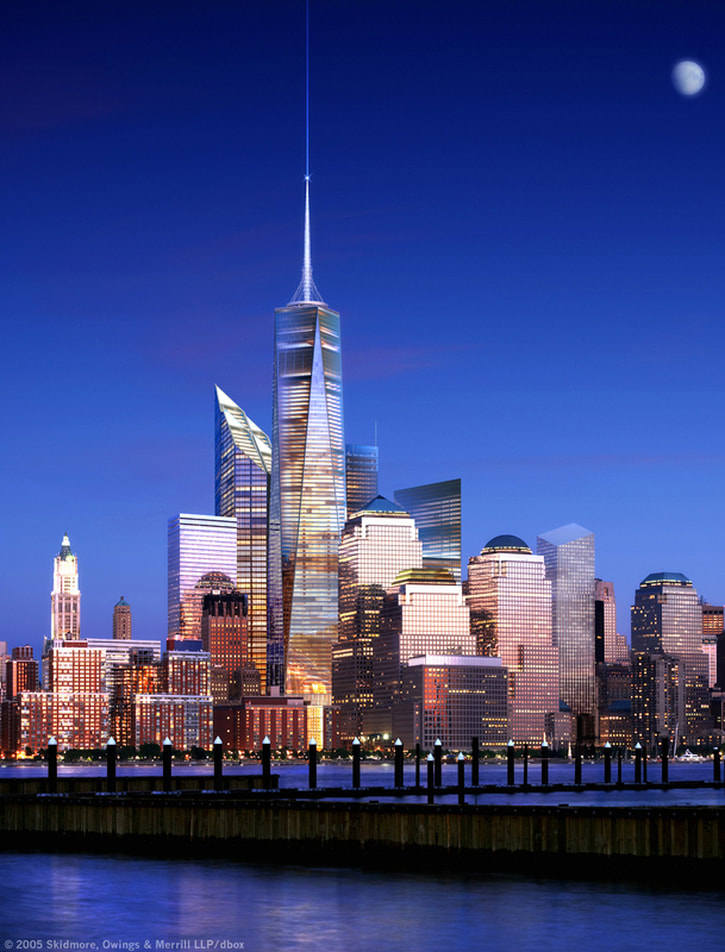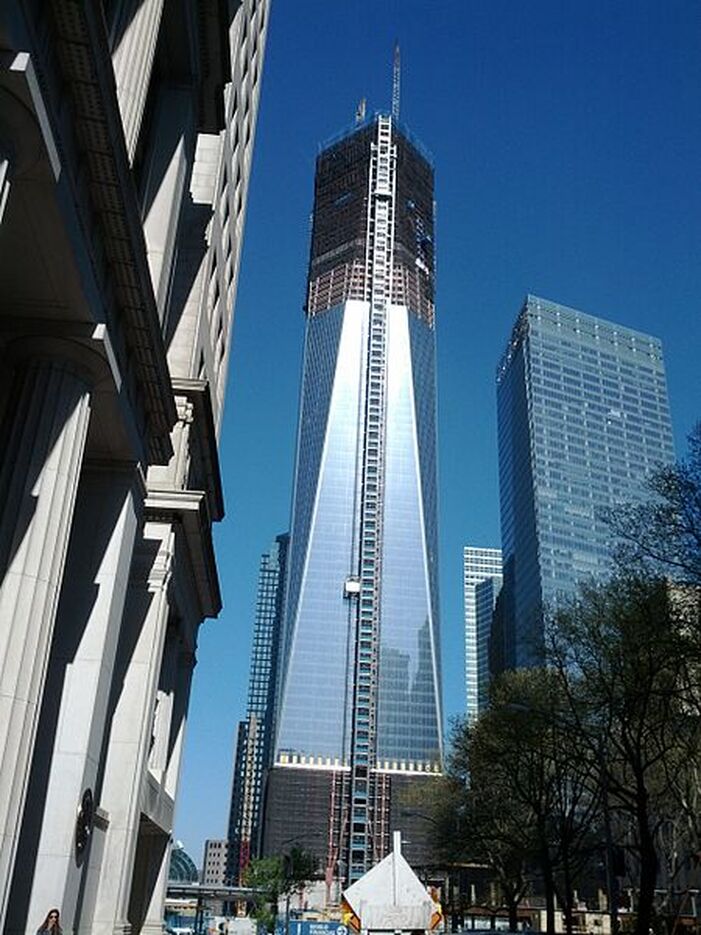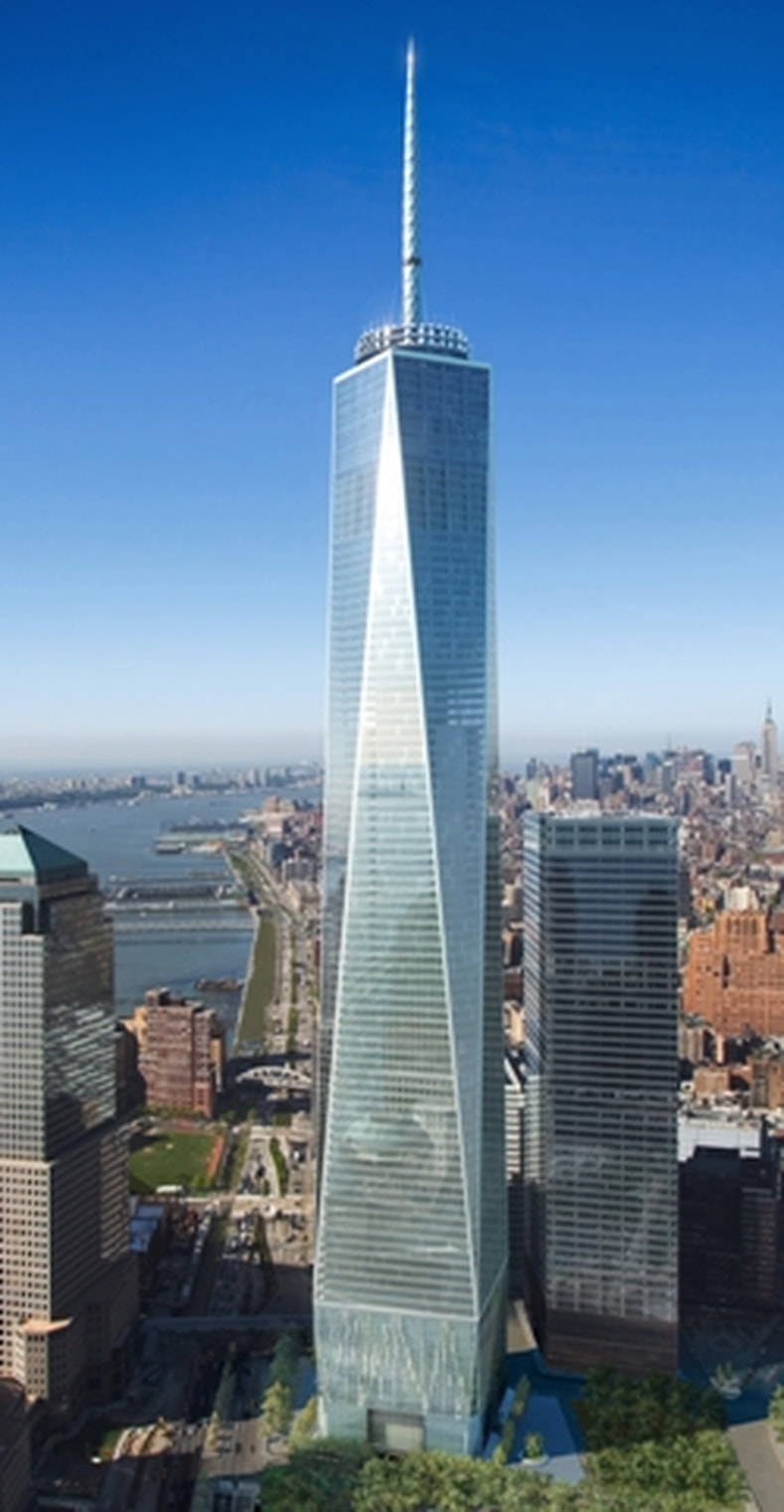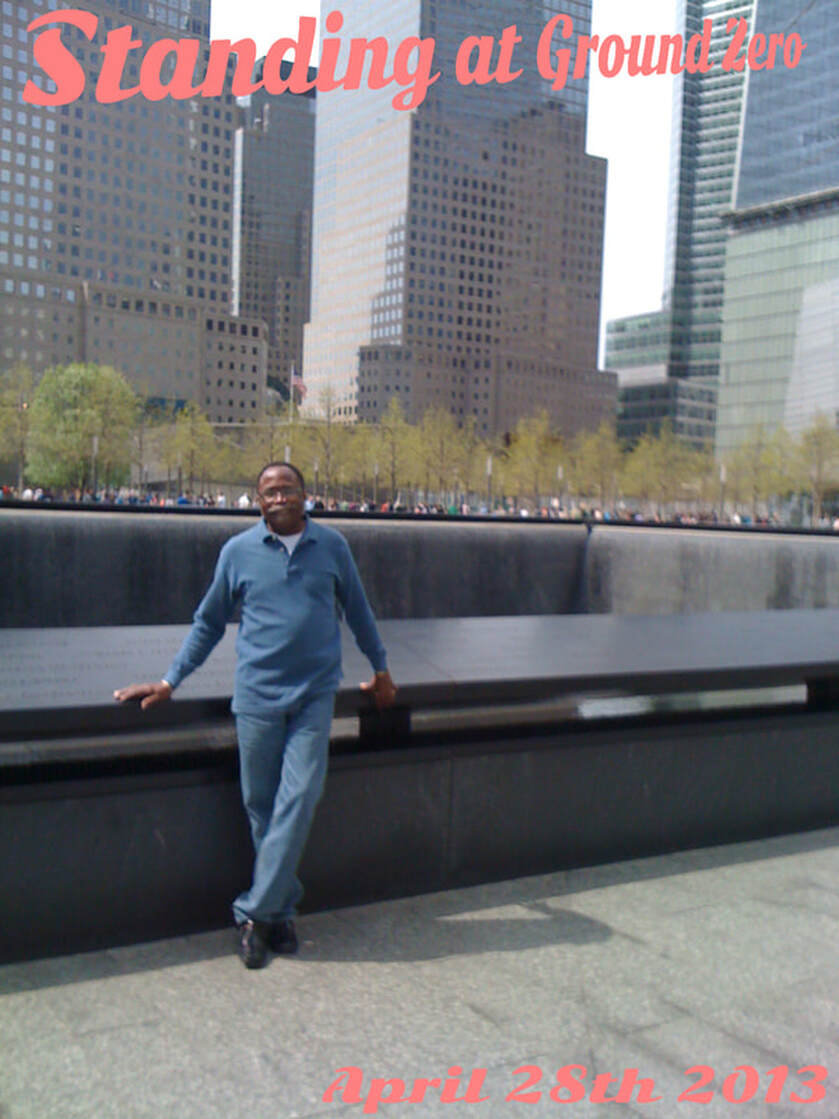One World Trade Center
Today: April 30th 2012 One World Trade Center has reached 1250 feet, surpassing the Empire Srate Building, and becoming the tallest Building in New York City, and the 3rd tallest in the World.
This is a day that every Architect in the world, particularly New York Architects (Myself Included); feels a deep sense of pride, especially to see the Architectural Firm: Skidmore Owings and Merrill making such a huge contribution to the Profession, even to today. Together with house hold Construction Company: Tishman Construction.
By The Way: See The Second Building In The Foreground To The Right Of The New Tower: That is Building "D" of The World Financial Center, and:
I WAS THE PROJECT ARCHITECT FOR THAT
One World Trade Center will be the tallest building in the Western Hemisphere
Architecture and design
Many remaining vestiges of the concepts drawn from the 2002 competition were later discarded from the tower's design. One World Trade Center's final design consisted of simple symmetries and a more traditional profile, intended to bear comparison with selected elements of the contemporary New York skyline.
The tower's central spire draws from precedents such as the Empire State Building and the Chrysler Building, and is also visually reminiscent of the North Tower of the original World Trade Center, rather than being an off-center spire intended to echo the Statue of Liberty.
When it comes to Architecture, there are words of the Critics, and there are words of the Architect who is rarely heard, fortunately for us, the Architect spoke, so lets hear what he has to say about this earth shaking Masterpiece:
David Childs of Skidmore, Owings and Merrill, the architect of One World Trade Center, said the following regarding the tower's design:
“ We really wanted our design to be grounded in something that was very real, not just in
sculptural sketches. We explored the infrastructural challenges because the proper solution
would have to be compelling, not just beautiful. The design does have great sculptural
implications, and we fully understand the iconic importance of the tower, but it also has
to be a highly efficient building.
The discourse about Freedom Tower has often been limited to the symbolic, formal and
aesthetic aspects but we recognize that if this building doesn't function well, if people
don't want to work and visit there, then we will have failed as architects".
Many remaining vestiges of the concepts drawn from the 2002 competition were later discarded from the tower's design. One World Trade Center's final design consisted of simple symmetries and a more traditional profile, intended to bear comparison with selected elements of the contemporary New York skyline.
The tower's central spire draws from precedents such as the Empire State Building and the Chrysler Building, and is also visually reminiscent of the North Tower of the original World Trade Center, rather than being an off-center spire intended to echo the Statue of Liberty.
When it comes to Architecture, there are words of the Critics, and there are words of the Architect who is rarely heard, fortunately for us, the Architect spoke, so lets hear what he has to say about this earth shaking Masterpiece:
David Childs of Skidmore, Owings and Merrill, the architect of One World Trade Center, said the following regarding the tower's design:
“ We really wanted our design to be grounded in something that was very real, not just in
sculptural sketches. We explored the infrastructural challenges because the proper solution
would have to be compelling, not just beautiful. The design does have great sculptural
implications, and we fully understand the iconic importance of the tower, but it also has
to be a highly efficient building.
The discourse about Freedom Tower has often been limited to the symbolic, formal and
aesthetic aspects but we recognize that if this building doesn't function well, if people
don't want to work and visit there, then we will have failed as architects".
There shall always be a World Trade Center in New York City
The symbolic cornerstone of One World Trade Center was laid in a ceremony on July 4, 2004, but further construction work was stalled until 2006 due to acrimonious disputes over money, security and design. The last major issues were resolved on April 26, 2006, when a deal was struck between developer Larry Silversteinand the Port Authority of New York and New Jersey.
For two months during the summer of 2006, explosives were detonated at the World Trade Center construction site, testing the use of charges to clear bedrock for the building's foundations. On November 18, 2006, 400 cubic yards (310 cubic metres) of concrete were poured onto the foundations, carried by as many as 40 trucks. On December 17, 2006, a ceremony was held in Battery Park City, with members of the public invited to sign a 30-foot (9.1 m) steel beam.
This beam, the first to be installed, was welded onto the building's base on December 19, 2006. Afterwards, construction of the foundation and further steel installation
commenced, and by the end of 2007, the tower’s footings and foundations were nearly complete.
For two months during the summer of 2006, explosives were detonated at the World Trade Center construction site, testing the use of charges to clear bedrock for the building's foundations. On November 18, 2006, 400 cubic yards (310 cubic metres) of concrete were poured onto the foundations, carried by as many as 40 trucks. On December 17, 2006, a ceremony was held in Battery Park City, with members of the public invited to sign a 30-foot (9.1 m) steel beam.
This beam, the first to be installed, was welded onto the building's base on December 19, 2006. Afterwards, construction of the foundation and further steel installation
commenced, and by the end of 2007, the tower’s footings and foundations were nearly complete.
Computer Rendering Of The completed One World Trade Center,
With 7 WTC Shown Nearby To The Right.
Its The Controversy In Developing These Project That We Architects Always Finds Most Interesting, This Project Was No Exception:
Following the destruction of the original World Trade Center on September 11, 2001, there was much debate regarding the future of the World Trade Center site. Proposals began almost immediately, and by 2003, the Lower Manhattan Development Corporation organized a competition to determine how to use the site.
Public rejection of the first round of designs, the "Preliminary Design Concepts," led to a second, more open competition in December 2002, in which a design by Daniel Libeskind was selected. This went through many revisions, largely because of disagreements with developer Larry Silverstein, who held the lease to the World Trade Center site on September 11, 2001. Criticism was leveled at the limited number of floors in an early plan that were designated for office space and other amenities.
Only 82 floors would have been habitable, and the overall office space of the entire rebuilt World Trade Center would have been reduced by more than 3,000,000 square feet (280,000 m2) in comparison with the original complex. The floor limit was imposed by Silverstein, who expressed concern that higher floors would be a liability in the event of a future terrorist attack or other incident.
Much of the building's height would have consisted of a large, open-air steel lattice structure above the roof of the tower, containing wind turbines and "sky gardens."
In a subsequent design, the highest space that could be occupied became comparable to the original World Trade Center, and the open-air lattice was removed from the plans. In 2005, during the tower's planning stages, former New York Governor George Pataki faced accusations of cronyism for supposedly using his influence to get the winning architect's bid picked as a personal favor for his friend and campaign contributor, Ron Lauder.
A final design for the "Freedom Tower" was formally unveiled on June 28, 2005. To satisfy security issues raised by the New York City Police Department, a 187-foot (57 m) concrete base was added in April of that year. The design originally included plans to clad the base in glass prisms to address criticism that it looked uninviting and resembled a "concrete bunker." However, this later proved unworkable, as preliminary testing revealed that the prismatic glass easily shattered into large and dangerous shards.
As a result, it was replaced by a simpler facade consisting of stainless steel panels and blast-resistant glass. Contrasting with Libeskind's plan, the final design tapers octagonally as it rises. Its designers stated that the tower would be a "monolithic glass structure reflecting the sky and topped by a sculpted antenna.
Public rejection of the first round of designs, the "Preliminary Design Concepts," led to a second, more open competition in December 2002, in which a design by Daniel Libeskind was selected. This went through many revisions, largely because of disagreements with developer Larry Silverstein, who held the lease to the World Trade Center site on September 11, 2001. Criticism was leveled at the limited number of floors in an early plan that were designated for office space and other amenities.
Only 82 floors would have been habitable, and the overall office space of the entire rebuilt World Trade Center would have been reduced by more than 3,000,000 square feet (280,000 m2) in comparison with the original complex. The floor limit was imposed by Silverstein, who expressed concern that higher floors would be a liability in the event of a future terrorist attack or other incident.
Much of the building's height would have consisted of a large, open-air steel lattice structure above the roof of the tower, containing wind turbines and "sky gardens."
In a subsequent design, the highest space that could be occupied became comparable to the original World Trade Center, and the open-air lattice was removed from the plans. In 2005, during the tower's planning stages, former New York Governor George Pataki faced accusations of cronyism for supposedly using his influence to get the winning architect's bid picked as a personal favor for his friend and campaign contributor, Ron Lauder.
A final design for the "Freedom Tower" was formally unveiled on June 28, 2005. To satisfy security issues raised by the New York City Police Department, a 187-foot (57 m) concrete base was added in April of that year. The design originally included plans to clad the base in glass prisms to address criticism that it looked uninviting and resembled a "concrete bunker." However, this later proved unworkable, as preliminary testing revealed that the prismatic glass easily shattered into large and dangerous shards.
As a result, it was replaced by a simpler facade consisting of stainless steel panels and blast-resistant glass. Contrasting with Libeskind's plan, the final design tapers octagonally as it rises. Its designers stated that the tower would be a "monolithic glass structure reflecting the sky and topped by a sculpted antenna.
